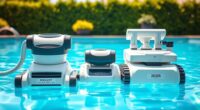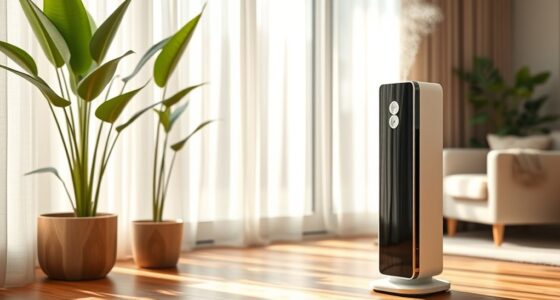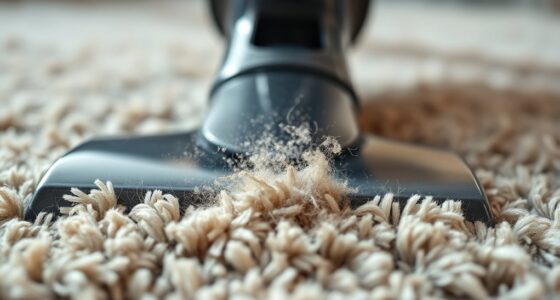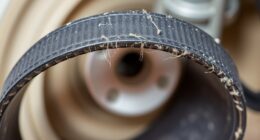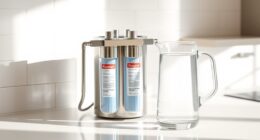Air purifiers really do deliver when it comes to improving indoor air quality. They use HEPA filters to capture at least 99.97% of airborne pollutants like dust, pollen, and pet dander, making them a great choice for allergy sufferers. However, they’re not a complete solution for gaseous pollutants, so consider models with activated carbon filters too. If you want to know what features to look for or how else to enhance your air quality, keep exploring further.
Key Takeaways
- Air purifiers effectively filter out airborne particles like dust, pollen, and pet dander using HEPA filters that capture 99.97% of contaminants.
- They struggle with gaseous pollutants, making activated carbon filters necessary for absorbing odors and volatile organic compounds (VOCs).
- Regular maintenance, including filter cleaning and replacement, is crucial for optimal performance and air quality improvement.
- While beneficial for allergies and asthma, air purifiers should be part of a broader strategy that includes ventilation and cleaning.
- They can reduce airborne virus concentrations, but are not a standalone solution for protection against illnesses like COVID-19.
How Do Air Purifiers Work?
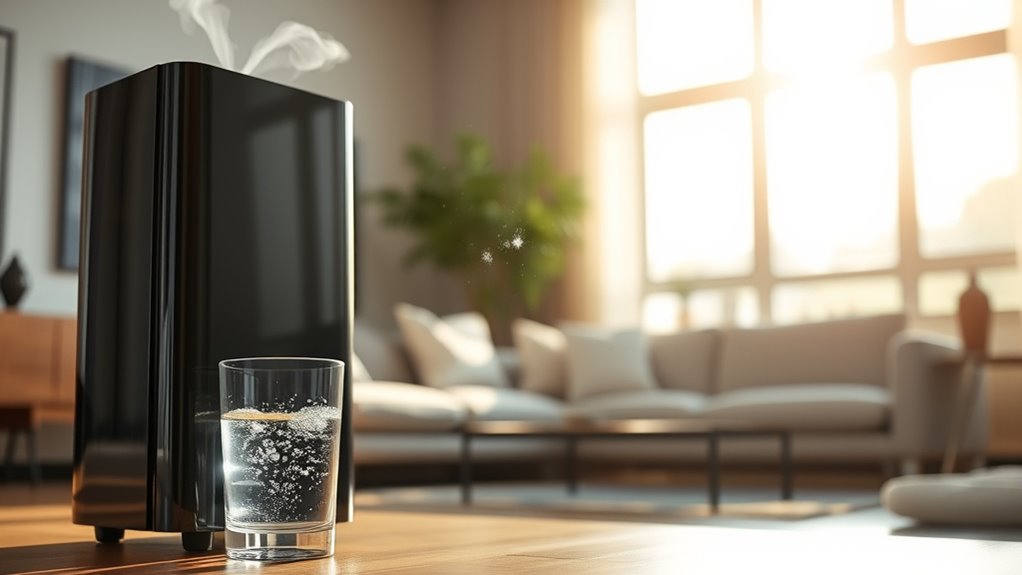
Air purifiers work by actively drawing in air from your space, filtering out contaminants, and then releasing cleaner air back into the room.
Air purifiers actively filter out contaminants from your space, releasing cleaner air back into the room.
They utilize a fan to pull air through various filters. Pre-filters catch larger particles, while HEPA filters capture at least 99.97% of particles 0.3 microns or larger, greatly improving indoor air quality. Regular cleaning is essential for optimal performance and effectiveness. Additionally, HEPA filters are particularly effective at reducing allergens, making them a popular choice for allergy sufferers. Many purifiers also feature advanced filtration technologies that enhance their ability to eliminate pollutants. Some models also include activated carbon filters to absorb odors and gases. The effectiveness of air purifiers is influenced by their Clean Air Delivery Rate (CADR), with a recommended rating of at least 300 for ideal performance. While portable units focus on single rooms, whole-house systems integrate with HVAC to enhance air quality throughout your home. Additionally, many purifiers are equipped with smart technology that allows for convenient operation and monitoring through WiFi and voice control. Regular maintenance is essential for continued effectiveness, including cleaning filters to ensure they operate at peak performance.
What Do Air Purifiers Filter Out?

Air purifiers are great for filtering out pesky airborne particles like dust, pollen, and pet dander. However, they struggle with gaseous pollutants, meaning you might need additional filters for things like VOCs. Regular use of air purifiers can lead to improved respiratory health, making it essential to understand what these devices can and can’t do to make the most of your air quality efforts. The use of HEPA filters ensures that 99.97% of airborne pollutants are effectively captured, enhancing the overall air quality in your home. Additionally, incorporating smart capabilities in some models allows for easier monitoring and adjustment of air quality settings for optimal performance. Having a home security system can further complement your indoor air quality efforts by ensuring a safe environment while you enjoy cleaner air. Additionally, modern heat pumps can significantly improve indoor air quality by filtering and circulating air, contributing to a healthier living space.
Particulate Matter Removal
Indoor air quality can profoundly impact your health, making it essential to understand what air purifiers filter out.
Air purification systems, especially those equipped with HEPA filters, are effective at capturing at least 99.97% of particulate matter that’s 0.3 microns in size. This means they can filter out dust, pollen, pet dander, and smoke, greatly improving your indoor environment. Additionally, using air purifiers can lead to improved energy efficiency by reducing the need for heating and cooling systems to work harder due to cleaner air circulation. Furthermore, maintaining color accuracy in your environment with proper lighting can enhance the overall ambiance and comfort. Engaging in activities like music therapy can also complement the benefits of cleaner air by promoting emotional well-being. Additionally, keeping your home clean by regularly dusting surfaces can help reduce the amount of particulate matter in the air.
While they can reduce PM2.5 concentrations by 50% or more, it’s important to note that they won’t eliminate all pollutants, particularly those embedded in surfaces like furniture.
To maintain peak performance, you should regularly replace filters and choose a model with a Clean Air Delivery Rate (CADR) of at least 300 for effective removal of particulate matter in larger spaces. Additionally, ensuring proper sun protection measures can further enhance overall health by reducing the risk of skin damage from UV exposure.
Gaseous Pollutants Limitations
While air purifiers excel at capturing particulate matter, they struggle considerably with gaseous pollutants.
Standard HEPA filters can effectively capture 99.97% of particles as small as 0.3 microns, but they fall short when faced with volatile organic compounds (VOCs) and radon. Additionally, the effectiveness of air purifiers can be enhanced by incorporating energy-efficient models that work in tandem with appropriate filtration systems. Understanding the limitations of air purifiers is crucial for making informed choices about divorce process and how it may impact your health. Using proper techniques for maintaining air quality can further enhance the overall effectiveness of your air purification efforts. Moreover, integrating essential oils into your cleaning routine can improve indoor air quality.
To combat these gaseous pollutants, you’ll need an activated carbon filter. This type of filter is designed specifically to adsorb gases, making it a crucial addition if you want to improve indoor air quality.
However, even with the right filters, the overall effectiveness of air purifiers against gaseous contaminants is often minimal. Proper planning can help ensure that you effectively manage indoor air quality, just as it is essential for maximizing retirement benefits.
For better results, it’s essential to control the sources of these pollutants in conjunction with using air purifiers.
Can Air Purifiers Improve Outdoor Air Quality?
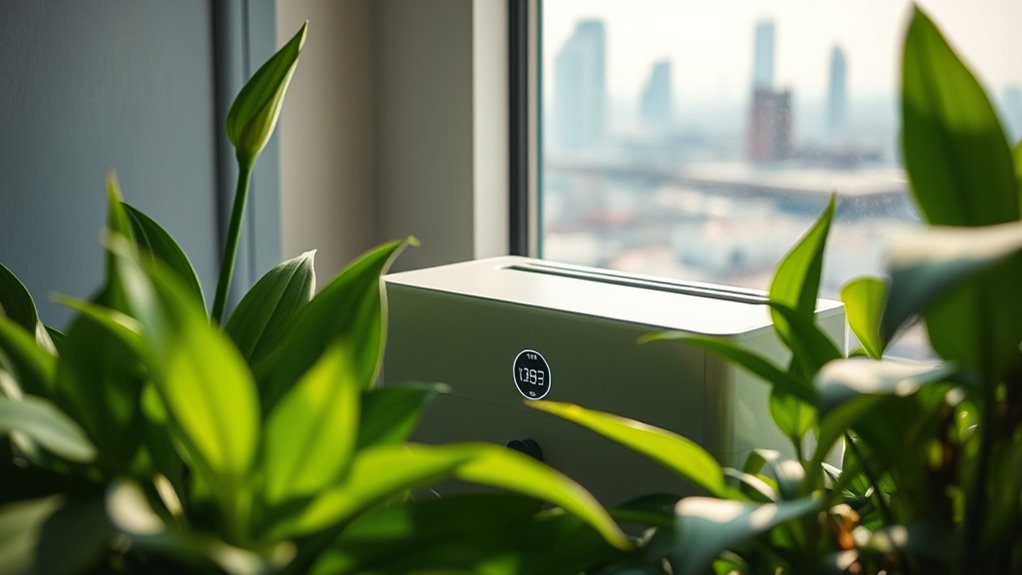
Although outdoor air quality can be poor due to factors like pollution and allergens, using air purifiers indoors can help mitigate these effects.
Air purifiers improve indoor air quality by capturing particles like dust, pollen, and smoke from outdoor sources, especially during high pollution events like wildfires. This can greatly reduce symptoms related to outdoor air pollutants, benefiting sensitive populations such as children and individuals with respiratory conditions.
However, keep in mind that while air purifiers can tackle particulate matter, they won’t filter gases like volatile organic compounds unless equipped with activated carbon filters. Additionally, establishing healthy sleep routines can further enhance overall well-being, especially in households with young children.
Regular use during elevated outdoor pollution levels helps maintain a healthier indoor environment, making it essential for your well-being.
Understanding HEPA Filters
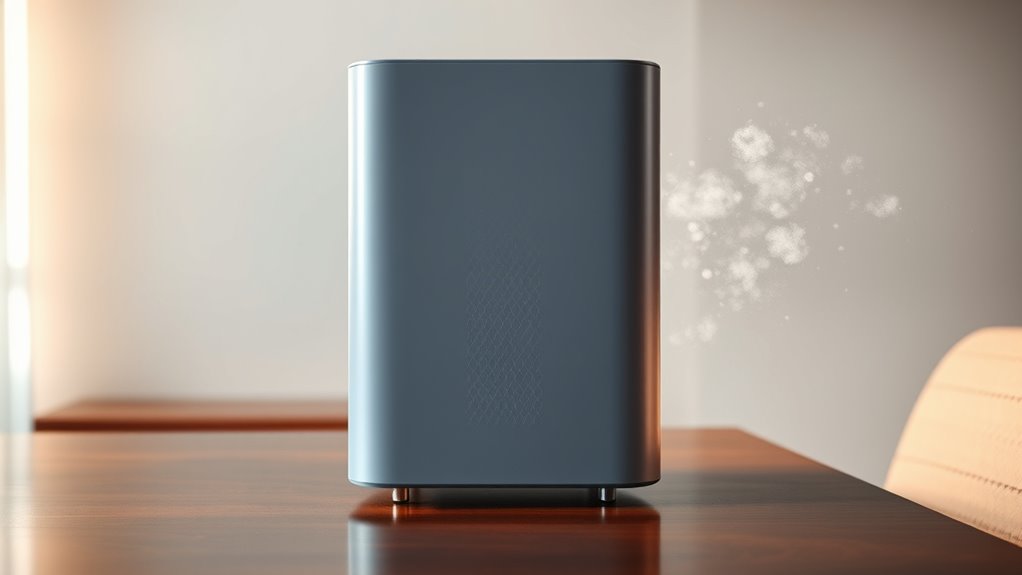
When you’re looking to improve your indoor air quality, understanding HEPA filters is vital.
HEPA filters, or High-Efficiency Particulate Air filters, capture at least 99.97% of airborne particles that are 0.3 microns in size. This makes them highly effective at removing allergens like dust, pollen, and pet dander from your home.
HEPA filters effectively capture 99.97% of airborne particles, making them essential for reducing allergens in your home.
Organizations like the CDC and EPA endorse HEPA filters for their efficiency and reliability. Their multi-layered structure, made from fine fiberglass threads, creates a dense matrix that traps these particles as air flows through.
However, keep in mind that HEPA filters don’t filter out gases like volatile organic compounds (VOCs). Regular maintenance and replacement are essential, as clogged filters can compromise airflow and filtration effectiveness.
Air Purifiers and COVID-19 Protection

As concerns about COVID-19 continue, many people are turning to air purifiers as a potential solution for improving indoor air quality and reducing virus transmission.
While air purifiers equipped with HEPA filters can capture particulates, including those that may carry the SARS-CoV-2 virus, they aren’t a guaranteed safeguard against COVID-19.
The CDC emphasizes that you shouldn’t rely solely on them for COVID-19 protection. Instead, a multi-layered approach is imperative, including masks and social distancing.
Studies suggest air purifiers can lower airborne virus concentrations, but their effectiveness depends on factors like room size and air circulation.
Choosing an air purifier with a True HEPA filter is vital for capturing up to 99.97% of harmful particles, enhancing your protection.
Do You Really Need an Air Purifier?
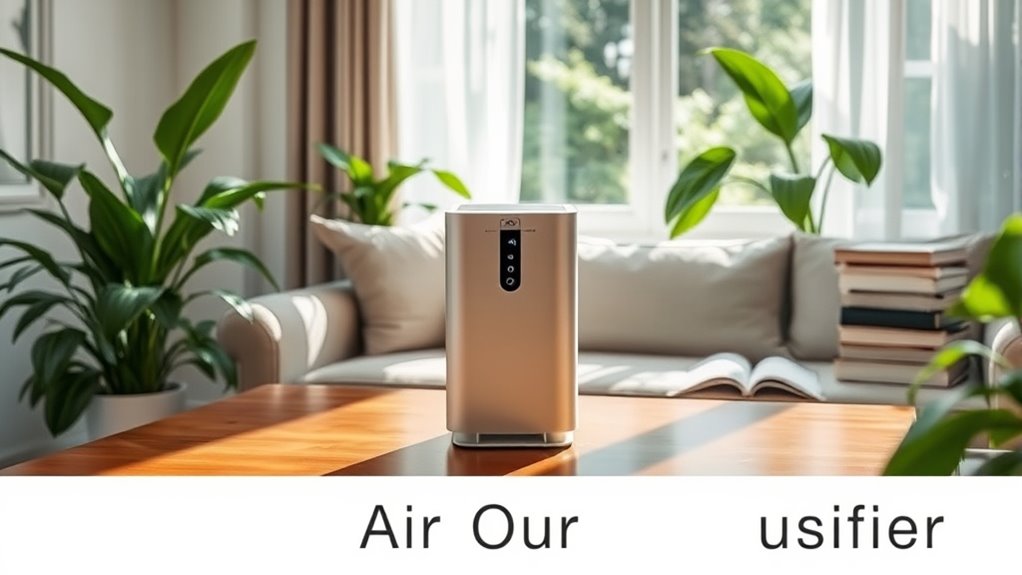
Do you really need an air purifier in your home? If you suffer from allergies or asthma, an air purifier can greatly improve air quality by capturing indoor pollutants like dust and pollen. However, they’re not a cure-all. You should combine them with proper ventilation and regular cleaning for the best results.
Here’s a quick glance at when an air purifier could be beneficial:
| Situation | Benefit | Notes |
|---|---|---|
| Allergies | Captures allergens | HEPA filters recommended |
| Smoke or Odors | Reduces unpleasant smells | Activated carbon filters needed |
| Pets | Minimizes pet dander | Regular cleaning still needed |
| High Pollution Areas | Filters outdoor pollutants | Choose higher CADR ratings |
| Asthma | Reduces triggers | Place in commonly used rooms |
Evaluate your needs before investing!
Key Features to Look for in an Air Purifier
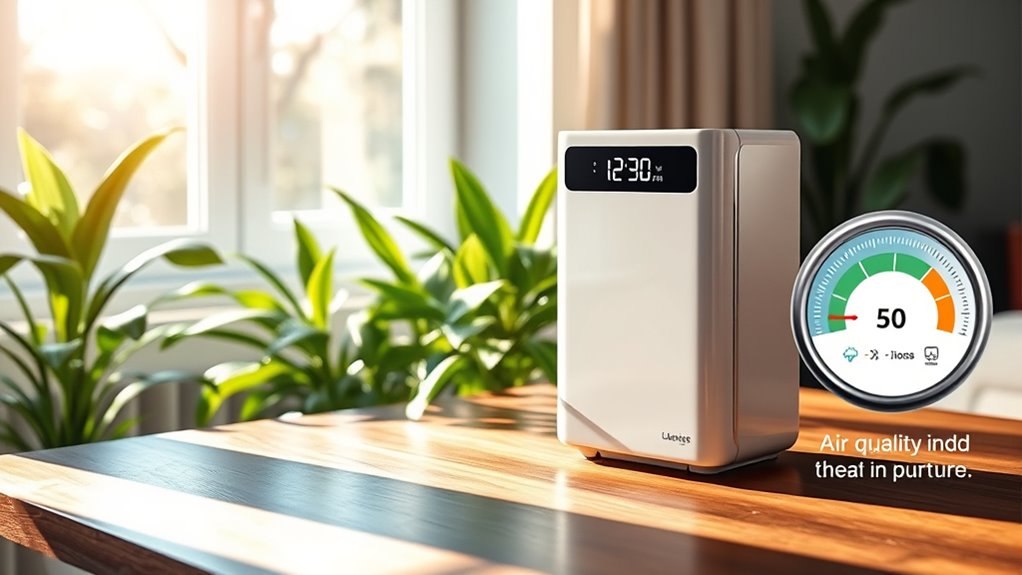
When you’re choosing an air purifier, it’s crucial to take into account the filter type, CADR rating, and room size compatibility.
A True HEPA filter and a high CADR rating guarantee effective removal of allergens and pollutants.
Plus, matching the purifier to your room size secures peak performance.
Filter Type Importance
Choosing the right filter type is essential for an effective air purifier. You’ll want to prioritize models with True HEPA air filters, as they capture at least 99.97% of particles down to 0.3 microns, guaranteeing peak air filtration for allergens like dust and pollen.
- Look for a Clean Air Delivery Rate (CADR) of at least 300 for quick and effective air purification.
- Consider air purifiers that combine HEPA filters with activated carbon filters to tackle odors and gases.
- Be wary of “HEPA-like” or “HEPA-type” filters, as they don’t meet True HEPA standards.
Regularly check and replace filters according to the manufacturer’s guidelines to maintain performance and guarantee you breathe clean air.
CADR Rating Considerations
Understanding the Clean Air Delivery Rate (CADR) is vital for making an informed decision about air purifiers. The CADR rating measures an air purifier’s efficiency in removing specific pollutants like smoke, dust, and pollen.
For effective performance in average-sized rooms, aim for a CADR rating of at least 300. Higher ratings mean faster air filtration, essential for maintaining good indoor air quality.
When choosing, look for an air purifier that excels across the contaminants relevant to your environment. Also, verify it’s AHAM certified, confirming that the CADR ratings are accurate and reliable.
Room Size Compatibility
Selecting the right air purifier for your space is essential, as a unit that’s too small won’t effectively clean the air.
To guarantee you choose the right model, consider the following:
- Check the Clean Air Delivery Rate (CADR) for compatibility with your room size.
- Look for the air changes per hour (ACH) rating; a higher ACH means better air filtration.
- Assess the specific pollutants in your space to determine if a larger filter is necessary.
Additional Ways to Enhance Indoor Air Quality
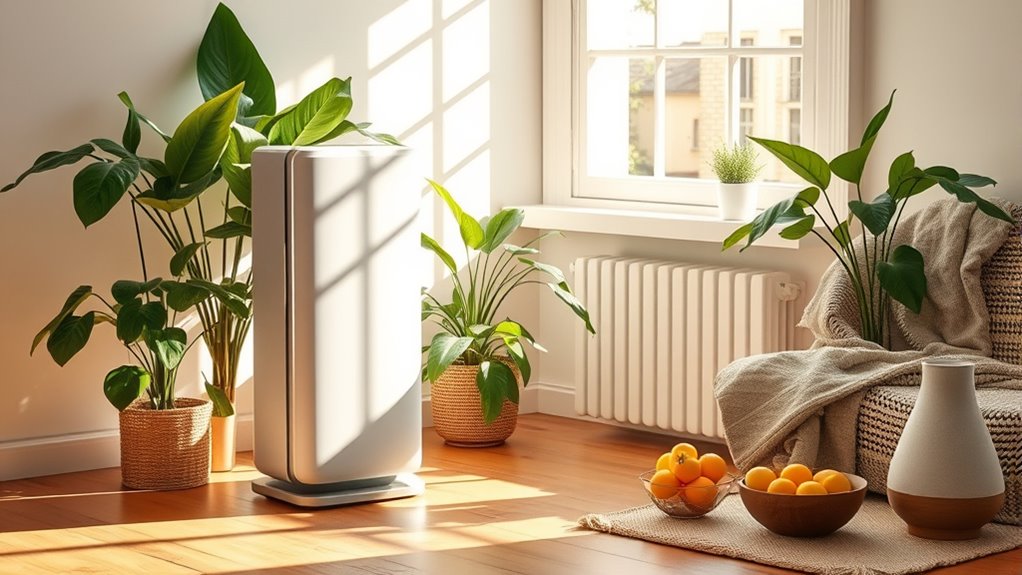
While air purifiers can play a significant role in enhancing indoor air quality, there are several additional strategies you can implement to create a healthier environment.
Start by regularly changing your HVAC filters, which are generally more effective with a MERV rating of 13-16 to trap smaller particles like dust and pollen.
Use exhaust fans in kitchens and bathrooms to reduce moisture and prevent mold growth.
Open windows for cross ventilation to improve air quality inside by allowing fresh air in.
Vacuum often with a HEPA-certified vacuum cleaner to capture allergens and pet dander.
Finally, limit the use of candles, wood-burning stoves, and indoor smoking to reduce harmful particulates and gases, further helping to improve air in your home.
Frequently Asked Questions
Do Air Purifiers Really Do Any Good?
Yes, air purifiers can really do good for your indoor air quality. When equipped with HEPA filters, they capture 99.97% of particles, markedly reducing allergens like dust and pet dander.
You might notice fewer allergy symptoms and improved breathing, especially if you have asthma. However, keep in mind they work best alongside regular cleaning and ventilation.
They won’t eliminate all pollutants, so don’t rely on them as your only solution.
What Do Doctors Say About Air Purifiers?
Doctors have mixed views on air purifiers. On one hand, they can greatly reduce airborne allergens, helping you breathe easier.
On the other hand, they aren’t a magic bullet. You’ll still need proper ventilation and source control for the best results.
HEPA filters are praised for capturing tiny particles, especially in tightly sealed homes.
While they may ease symptoms, remember that good hygiene and airflow are essential, too.
Do Air Purifiers Run up Your Electric Bill?
Yes, air purifiers can run up your electric bill, especially if you use them on high settings continuously.
Most models consume between 30 to 100 watts, which can lead to an increase of $10 to $30 per month.
However, you can keep costs down by choosing energy-efficient models with ENERGY STAR certification.
Also, using them strategically in occupied rooms or during allergy seasons helps reduce energy consumption while still improving air quality.
What Are the Negatives of Air Purifiers?
Did you know that around 50% of air purifiers don’t effectively filter out gases or VOCs?
While they can help reduce certain pollutants, they often fall short in eliminating mold spores or preventing growth, as controlling moisture is key.
Some models produce ozone, which can irritate your lungs.
Plus, the ongoing costs of filter replacements can really add up, making air purifiers less economical than you might expect.
Conclusion
In the journey of breathing clean air, an air purifier is like a trusty lantern, illuminating the path through a foggy forest. While it won’t clear every shadow, it can certainly chase away many lurking pollutants. As you weigh your options, remember that this tool is just one part of your quest for fresh indoor air. Embrace additional strategies, too, and together, they’ll guide you to a healthier, more vibrant home environment.

